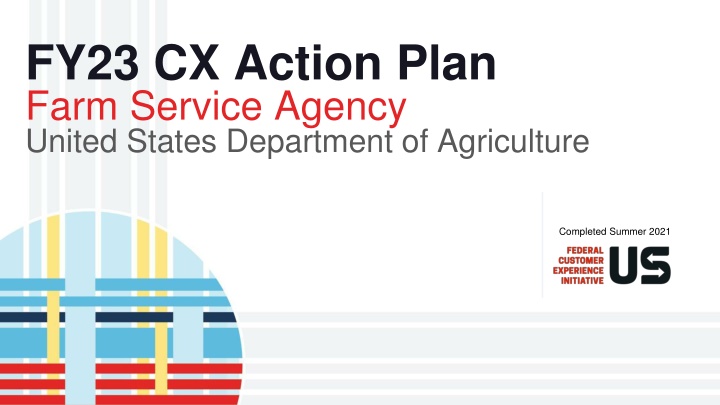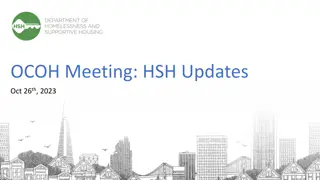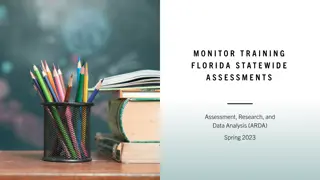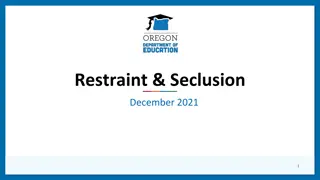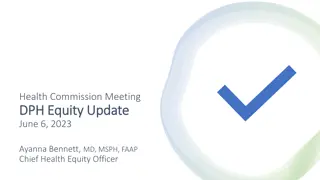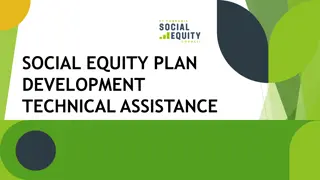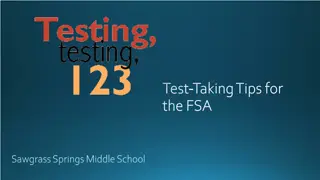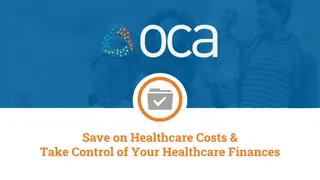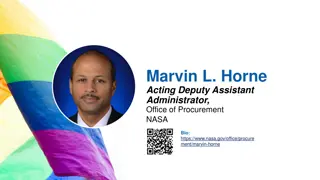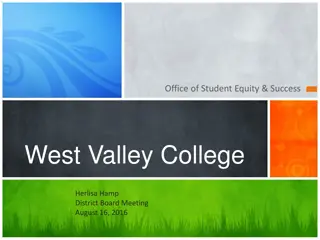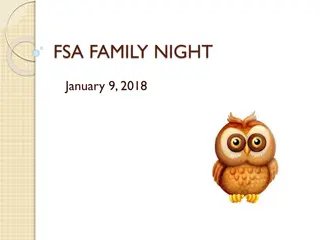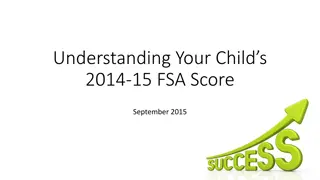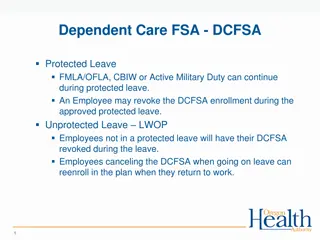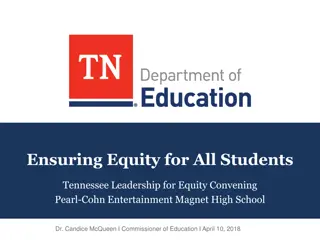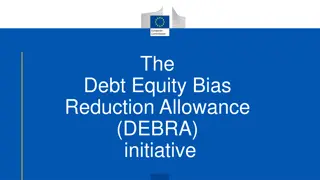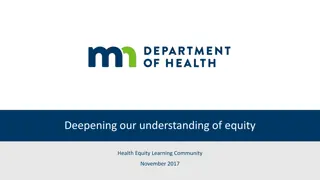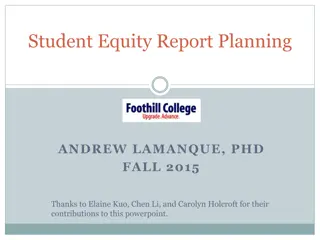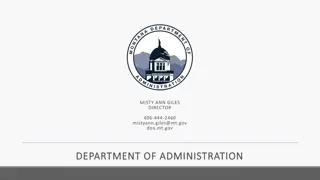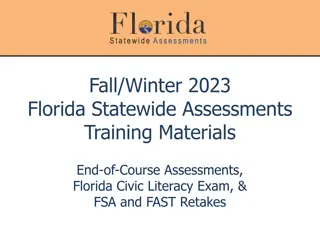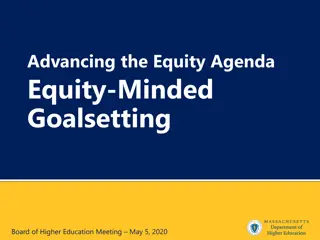FSA Service Innovations & Equity Reflection
This content showcases the innovative service adaptations by the Farm Service Agency (FSA) in response to the global pandemic, including online document submission tools, along with reflections on equity and underserved producer groups. The agency highlights achievements, areas for improvement, and the need for better understanding of interactions with historically marginalized individuals.
Uploaded on Mar 09, 2025 | 0 Views
Download Presentation

Please find below an Image/Link to download the presentation.
The content on the website is provided AS IS for your information and personal use only. It may not be sold, licensed, or shared on other websites without obtaining consent from the author.If you encounter any issues during the download, it is possible that the publisher has removed the file from their server.
You are allowed to download the files provided on this website for personal or commercial use, subject to the condition that they are used lawfully. All files are the property of their respective owners.
The content on the website is provided AS IS for your information and personal use only. It may not be sold, licensed, or shared on other websites without obtaining consent from the author.
E N D
Presentation Transcript
FY23 CX Action Plan Farm Service Agency United States Department of Agriculture Completed Summer 2021
FY21 Capacity Assessment Reflection Summary What we re proud of this year: Producer Satisfaction Customer Survey iLab Research Project to develop improved experience for historically underserved customers FSA Producer Program Help Line Development and rollout of Farm Stress training for producer-facing staff Efforts to improve collection of DEI-related data in future producer surveys Where we need to do better: Increase presence of outreach efforts among underserved producer groups Build staff capacity to effectively support producers from underserved groups 2
Adapting Service During a Global Pandemic Where we innovated Online document submission (Box/One Span) Prior to the pandemic, farmers were required to bring in documents related to program enrollment to their local USDA Service Center. In response to both prior customer requests and public health concerns, FSA was able to implement online document submission tools to enable farmers to provide this information without having to visit in person. Customers are able to securely conduct business from home by accessing, signing and submitting documents securely online. Thousands of farmers have utilized this online service without putting their safety at risk during COVID-19. This will be implemented as a permanent feature and improvements are underway. 3
HISP Equity Reflection Who is this provider intended to serve? Agricultural producers, farmers, ranchers and landowners and the group associations they make up. Are there barriers that people of color, people with disabilities, LGBTQ+ people, women, non-native English speakers, and others who have been historically underserved, marginalized, discriminated, and adversely affected by persistent poverty and inequality face with regard to this program or service? Yes, over the years these groups have experienced barriers to accessing services which has resulted in a lack of trust. How might these individuals interact with your program differently? Producers from these groups often have a different cultural context than the staff with whom they work. If a farmer is part of a group that has historically faced discrimination related to land tenure, for example, they may have concerns that their local staff contacts are unprepared to address. These producers are also less likely to feel comfortable bringing up sensitive topics (such as financial concerns related to their operations) with staff who do not come from the same background. 4 Where do we have a knowledge gap about individuals interactions with our service we need evidence to fill? We need more data on which interactions are most likely to be challenging for underserved producer groups, as well as the specific types of resources and support that will enable staff to improve the quality of the service they provide.
FY22 Action Update: Build staff capacity to deliver positive service experiences to underserved producers What customer need will this action address? Producers from underserved groups have reported lower levels of trust and perceived discrimination in their interactions with FSA staff. Internal research suggests that one cause may be a lack of training and support resources for employees working in a cultural context with which they are unfamiliar. By developing better support structures for them, we hope to increase their ability to provide equitable and high-quality services for all producers, but particularly those who have faced past discrimination. Why is this a priority? President Biden issued an Executive Order 13985 which requires federal agencies to examine barriers to underserved participation in federal programs/services. USDA Secretary Thomas Vilsack is committed to identifying and correcting racial inequalities and barriers to underserved participation in USDA programs. Who is responsible for this action happening? FSA s Director of Outreach is managing this charge for the FSA Administrator in collaboration with the FPAC CX Innovation Lab What action(s) / deliverables / milestones will you take / hit between Oct. 1, 21 Sept. 30, 22? Complete staff and stakeholder research activities Finalize analysis to present to FSA Administrator Co-create prototype solutions to address these issues Implement targeted pilots 5 How will you measure whether these actions had their intended effect? Qualitative and quantitative research with staff and producers Analysis of complaint data in pilot areas relative to control areas What do you need to make this happen? Continued support from FPAC CX team; possible budgetary resources depending on nature of solution
FY22 Action Update: Pilot online appointment scheduling for producers What customer need will this action address? While online document submission has been successfully implemented, there are still times when a producer needs to speak with staff in person to receive advice or assistance. However, because many USDA Service Centers are understaffed and located in rural areas, producers may drive long distances only to find that no staff is available to meet with them. By setting up an online appointment system, producers are more likely to be able to meet with staff the first time they try to do so. Why is this a priority? Recent producer surveys have indicated that many farmers believe that in-person interactions are a critical part of their FSA relationship. By streamlining the meeting scheduling process, FSA can continue to position itself as a trusted and reliable partner for American producers. Who is responsible for this action happening? FSA DAFO in collaboration with the FPAC Business Center (responsible for IT support) What action(s) / deliverables / milestones will you take / hit between Oct. 1, 21 Sept. 30, 22? Piloted usage of Microsoft Teams to allow producers to schedule appointments How will you measure whether these actions had their intended effect? Usage of service in pilot areas Qualitative feedback from producers and staff 6 What do you need to make this happen? Continued access to Microsoft Teams (or a similar product); continued collaboration with the FPAC Business Center
FY23 Commit to Action: Use geographic data to improve targeting of outreach efforts for Tribal producers What customer need will this action address? Tribal producers living on reservations have unique needs due to complex land regulations. However, these producers have also reported that accessing USDA services can be difficult because of both physical distance from USDA Service Centers and limited presence of FSA staff in their region. By utilizing existing GIS data to identify the largest discrepancies between Tribal producer location and FSA presence, the agency will be better able to implement services targeted towards the highest-need producers. Why is this a priority? According to the USDA s Food Access Research Atlas, the majority of Native American reservations include food deserts low-income census tracts where residents are more than one mile (urban) or 10 miles (rural) from the nearest supermarket. As such, supporting Tribal producers in improving the productivity and economic growth of their operations is a critical step in promoting local food sovereignty and reducing food insecurity. Who is responsible for this action happening? FSA Outreach What action(s) / deliverables / milestones will you take / hit between Oct. 1, 22 Sept. 30, 23? Analyze GIS data to determine geographic focus areas Develop strategic plan for increasing outreach activities and presence in those regions Pilot outreach activities in target areas Develop plan for mainstreaming use of GIS data in future outreach planning efforts 7 How will you measure whether these actions had their intended effect? Qualitative and quantitative feedback from producers in target areas What do you need to make this happen? Collaboration with the Office of Tribal Relations; possible budgetary support for outreach activities
FY23 Commit to Action: Centralize and improve user-friendliness of Beginning Farmer and Rancher (BFR) resources online What customer need will this action address? Beginning farmers and ranchers (BFRs), in addition to utilizing FSA s general programs, have unique needs relative to the larger American producer population. However, BFR resources are currently disaggregated and not co-located with more generalized USDA support. As a result, locating this information can be difficult and inconvenient. By centralizing these resources and ensuring that they re available in a user-friendly manner, FSA will make it easier for these producers to access and engage with them. Why is this a priority? According to the 2017 Agricultural Census, the average American farmer is 57.5 years old. However, BFRs, who are typically younger, are also a rapidly growing cohort; a 2019 USDA report indicates that 17% of all American farms are entirely operated by new farmers. Supporting this group is critical to ensuring that American agriculture remains a vital and productive sector. Who is responsible for this action happening? FSA Outreach in collaboration with the FPAC Business Center What action(s) / deliverables / milestones will you take / hit between Oct. 1, 22 Sept. 30, 23? Prototype centralized pages or platforms for these resources as part of FSA s larger information repository (likely farmers.gov) Collect user feedback and refine design Launch new online home for BFR resources 8 How will you measure whether these actions had their intended effect? Metadata related to site visits and document access Qualitative and quantitative feedback from BFRs What do you need to make this happen? Support from FPAC Business Center and related contractors
Commitments from Executive Order 14058 On December 13th, 2021 (after agencies originally developed these action plans as part of the FY23 budget formulation process), President Biden signed Executive Order 14058 on Transforming Federal Customer Experience and Service Delivery To Rebuild Trust in Government. Section 4 of this Order was developed by working with HISPs to identify specific improvements to their core services (many of which were proposed in their FY23 Action Plans), to lift up and energize their existing efforts, improving accountability and support. For FSA, EO 14058 commitments include: Designing and implementing a simplified direct farm loan application process. For more updates on agency progress on specific commitments, please visit https://www.performance.gov/cx/executive-order/.
